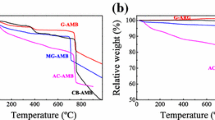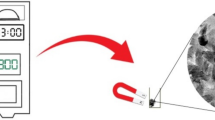Abstract
Carbon-based magnetic nanocomposites are of large interest for applications in catalysis, magnetic separation, water cleaning, and magnetic resonance imaging, among others. This work describes the synthesis of nanocomposites consisting of iron oxides dispersed into a char (obtained from the carbonization at 700 °C of a lignocellulosic precursor) and the study of the thermal transformations occurring in these materials as a consequence of heat treatments. The materials were prepared by impregnation of the char with iron nitrate in the presence of ammonium hydroxide in aqueous suspension. X-ray diffraction experiments performed using synchrotron radiation and Mössbauer spectroscopy showed that the as-prepared material was composed of amorphous Fe3+ oxides. Scanning electron microscopy images combined with energy-dispersive X-ray spectrometry indicated a homogeneous dispersion of iron oxides and of silica particles (naturally present in the lignocellulosic precursor) throughout the char. X-ray diffractograms recorded in situ during the heat treatment of the as-prepared material showed the presence of small hematite crystallites (average size ~22 nm) starting from ca. 300 °C. Further heating caused a progressive growth of the hematite crystallites up to ca. 500 °C, when the conversion to magnetite (Fe3O4) started to take place. At higher temperatures, wüstite (Fe1−xO) was detected as an intermediate phase and austenitic iron (γ-Fe) became the dominant phase at temperatures from 900 °C. A steep weight loss was observed in the TG curve accompanying this last reduction stage; upon cooling, γ-Fe was converted into α-Fe (ferrite), which was the dominant phase at room temperature in this heat-treated sample.









Similar content being viewed by others
References
Ayyub P, Multani M, Barma M, Palkar VR, Vijayaraghavan R (1988) Size-induced structural phase transitions and hyperfine properties of microcrystalline Fe2O3. J Phys C 21:2229–2245
Belmouden M, Assabane A, Ichou YA (2000) Adsorption characteristics of a phenoxy acetic acid herbicide on activated carbon. J Environ Monit 2:257–260
Bodker F, Morup S, Linderoth S (1994) Surface effects in metallic iron nanoparticles. Phys Rev Lett 72:282–285
Chang Q, Lin W, Ying W (2010) Preparation of iron-impregnated granular activated carbon for arsenic removal from drinking water. J Hazard Mater 184:515–522
Chen W, Parette R, Zou J, Cannon FS, Dempsey BA (2007) Arsenic removal by iron-modified activated carbon. Water Res 41:1851–1858
Cheng W, Dastgheib SA, Karanfil T (2005) Adsorption of dissolved natural organic matter by modified activated carbons. Water Res 39:2281–2290
Cooper AM, Hristovski KD, Möller T, Westerhoff P, Sylvester P (2010) The effect of carbon type on arsenic and trichloroethylene removal capabilities of iron (hydr)oxide nanoparticle-impregnated granulated activated carbons. J Hazard Mater 183:381–388
Cornell RM, Schwertmann U (2003) The iron oxides: Structure, properties, reactions, occurrences and uses, 2nd edn. Wiley-VCH, Weinheim
Emmerich FG, Sousa JC, Torriani IL, Luengo CA (1987) Applications of a granular model and percolation theory to the electrical resistivity of heat treated endocarp of babassu nut. Carbon 25:417–424
Fierro V, Muñiz G, Gonzales-Sanchez G, Ballinas ML, Celzard A (2009) Arsenic removal by iron-doped activated carbons prepared by ferric chloride forced hydrolysis. J Hazard Mater 168:430–437
Freitas JCC, Emmerich FG, Bonagamba TJ (2000) High-resolution solid-state NMR study of the occurrence and thermal transformations of silicon-containing species in biomass materials. Chem Mater 12:711–718
Greenwood NN, Gibb TC (1971) Mössbauer spectroscopy. Chapman and Hall, London
Gu Z, Fang J, Deng B (2005) Preparation and evaluation of GAC-based iron-containing adsorbents for arsenic removal. Environ Sci Technol 39:3833–3843
Guedidi H, Reinert L, Lévêque JM, Soneda Y, Bellakhal N, Duclaux L (2013) The effects of the surface oxidation of activated carbon, the solution pH and the temperature on adsorption of ibuprofen. Carbon 54:432–443
Hristovski KD, Westerhoff PK, Möller T, Sylvester P (2009) Effect of synthesis conditions on nano-iron (hydr)oxide impregnated granular activated carbon. Chem Eng J 146:237–243
Inagaki M, Okada Y, Miura H, Konno K (1999) Preparation of carbon-coated transition metal particles from mixtures of metal oxide and polyvinylchloride. Carbon 37:329–334
Li Z, Zhang T, Li K (2011) One-step synthesis of mesoporous two-line ferrihydrite for effective elimination of arsenic contaminants from natural water. Dalton Trans 40:2062–2066
Lowell S, Shields JE, Thomas MA, Thommes M (2006) Characterization of porous solids and powders: surface area, pore size and density. Springer, Dordrecht
Machala L, Zboril R, Gedanken A (2007) Amorphous iron(III) oxide—a review. J Phys Chem B 111:4003–4018
Malini KA, Anantharaman MR, Gupta A (2004) Low temperature Mössbauer studies on magnetic nanocomposites. Bull Mater Sci 27:361–366
Muñiz G, Fierro V, Celzard A, Furdin G, Gonzales-Sanchez G, Ballinas ML (2009) Synthesis, characterization and performance in arsenic removal of iron-doped activated carbons prepared by impregnation with Fe(III) and Fe(II). J Hazard Mater 165:893–902
Oliveira LCA, Rios RVRA, Fabris JD, Garg V, Sapag K, Lago RM (2002) Activated carbon/iron oxide magnetic composites for the adsorption of contaminants in water. Carbon 40:2177–2183
Phu ND, Ngo DT, Hoang LH, Luong NH, Chau N, Hai NH (2011) Crystallization process and magnetic properties of amorphous iron oxide nanoparticles. J Phys D Appl Phys 44:345002
Rudge SR, Kurtz TL, Vessely CR, Catterall LG, Williamson DL (2000) Preparation, characterization, and performance of magnetic iron-carbon composite microparticles for chemotherapy. Biomaterials 21:1411–1420
Sajitha EP, Prasad V, Subramanyam SV, Eto S, Takai K, Enoki T (2004) Synthesis and characteristics of iron nanoparticles in a carbon matrix along with the catalytic graphitization of amorphous carbon. Carbon 42:2815–2820
Schettino MA Jr, Freitas JCC, Morigaki MK, Nunes E, Cunha AG, Passamani EC, Emmerich FG (2010) High-temperature XRD study of thermally induced structural and chemical changes in iron oxide nanoparticles embedded in porous carbons. J Nanopart Res 12(8):3097–3103
Schettino MA Jr, Gonçalves GR, Morigaki MK, Nunes E, Cunha AG, Passamani EC, Emmerich FG, Nascente PAP, Freitas JCC (2012) Synthesis, characterization and study of thermal behavior of nanostructured iron oxides embedded in porous carbon prepared from the decomposition of iron pentacarbonyl. In: Martinez AI (ed) Iron Oxides: Structure, properties and applications, Chapter 2. Nova Science Publishers, Hauppage, pp 19–51
Schwarz JA, Contescu C, Contescu A (1995) Methods for preparation of catalytic materials. Chem Rev 25:447–510
Shipley HJ, Engates KE, Guettner AM (2011) Study of iron oxide nanoparticles in soil for remediation of arsenic. J Nanopart Res 13:2387–2397
Sperlich A, Werner A, Genz A, Amy G, Worch E, Jekel M (2005) Breakthrough behavior of granular ferric hydroxide (GFH) fixed-bed adsorption filters: modeling and experimental approaches. Water Res 39:1190–1198
Zhang QL, Lin YC, Chen X, Gao NY (2007) A method for preparing ferric activated carbon composites adsorbents to remove arsenic from drinking water. J Hazard Mater 148:671–678
Acknowledgments
This work has been supported by the Brazilian Synchrotron Light Laboratory (LNLS) under proposals D10B - XPD 11741 and XRD1 14271. The support of CAPES, CNPq, FAPES, and FINEP is also gratefully acknowledged.
Author information
Authors and Affiliations
Corresponding author
Rights and permissions
About this article
Cite this article
Gonçalves, G.R., Schettino, M.A., Morigaki, M.K. et al. Synthesis of nanostructured iron oxides dispersed in carbon materials and in situ XRD study of the changes caused by thermal treatment. J Nanopart Res 17, 303 (2015). https://doi.org/10.1007/s11051-015-3092-4
Received:
Accepted:
Published:
DOI: https://doi.org/10.1007/s11051-015-3092-4




